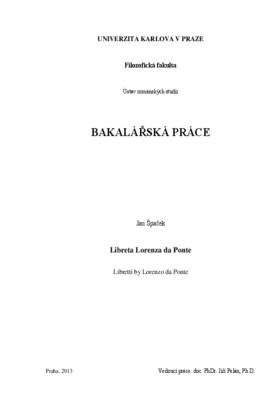Libreta Lorenza Da Ponte
Libretti by Lorenzo Da Ponte
bakalářská práce (OBHÁJENO)

Zobrazit/
Trvalý odkaz
http://hdl.handle.net/20.500.11956/54744Identifikátory
SIS: 121872
Katalog UK: 990016258840106986
Kolekce
- Kvalifikační práce [24991]
Autor
Vedoucí práce
Oponent práce
Žáčková, Magdalena
Fakulta / součást
Filozofická fakulta
Obor
Italianistika
Katedra / ústav / klinika
Ústav románských studií
Datum obhajoby
11. 9. 2013
Nakladatel
Univerzita Karlova, Filozofická fakultaJazyk
Čeština
Známka
Dobře
Klíčová slova (česky)
libreto, italská literaturaKlíčová slova (anglicky)
libretto, italian literatureTématem bakalářské práce jsou libreta italského básníka Lorenza da Ponte. Práce se zabývá bio-bibliografickým medailonkem autora, analýzou tří operních libret a charakteristickými rysy da Pontových textů se stručným porovnáním s tvorbou italského libretisty a básníka Pietra Metastasia. Italská libreta jsou rozdělena do tří hlavních kapitol: Le nozze di Figaro, Il dissoluto punito ossia il don Giovanni a Così fan tutte ossia la scuola degli amanti. V jednotlivých částech jsou popsány oddělené analýzy výše zmíněných operních libret. Úvod každé kapitoly charakterizuje konkrétní dílo a okolnosti jeho vzniku. Podrobnější analýza si klade za cíl popsat vystupující postavy a jejich případné proměny v průběhu děje, analyzovat rým ve strofě, identifikovat specifické slovní obraty, metafory a pojmenování. Závěr každé kapitoly je zakončen nejdůležitějšími poznatky a případnými anomáliemi, které v průběhu analýzy byly objeveny a zjištěny.
The theme of the bachelor thesis is Italian libretti by the poet Lorenzo da Ponte. The thesis is dealing with a bio-bibliographical aspect of the author, analyses of three opera libretti and characteristics of texts written by da Ponte with a brief comparison with the work of the Italian poet and librettist Pietro Metastasio. Italian libretti are divided into three main chapters: Le nozze di Figaro, Il dissoluto punito ossia il don Giovanni and Così fan tutte ossia la scuola degli amanti. In individual parts descriptions are divided into a separate analysis of the above mentioned opera libretti. Introduction of each chapter describes a specific work and circumstances of its creation. A more detailed analysis aims to describe prominent figures and their possible changes in the course of the plot, analyze rhythm in stanzas and identify specific phrases, metaphors and naming. Conclusion of each chapter ends with the most important findings and the potential anomalies, which were discovered during the analysis.
